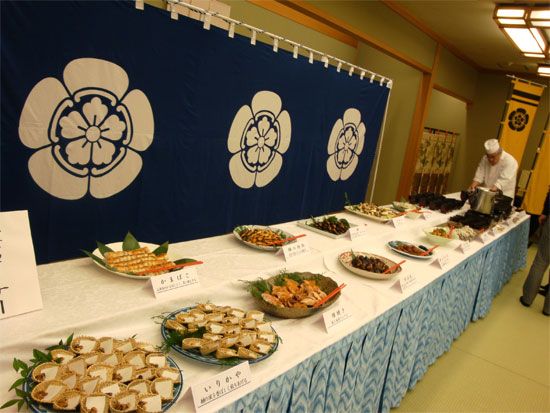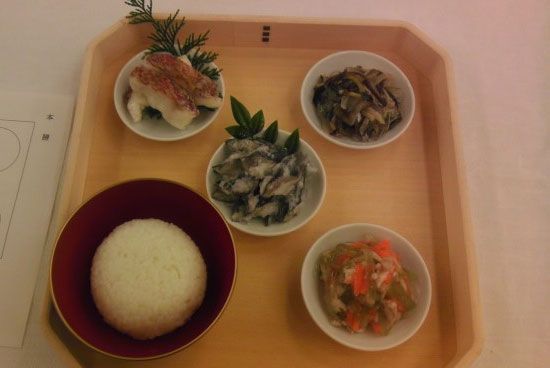かたじけない.
This said, if you happen in Azuchi, you'd probably consider to take a peek to the museum area a few chilometers away from the ruins of the castle.
In there a must-see place is the Nobunaga no Yakata, a little building where you can see the reproduction of the tenshu of Azuchi Castle.
Among the various little permanent exhibitions of the place a fancy one is that dedicated to the banquet held in Azuchi on the May of 1581 in honor of Tokugawa Ieyasu's visit.


Akechi Mitsuhide took care of the huge task and came with a lavish banquet that struck awe in all the attendants because it sported dishes from the various provinces conquered by Nobunaga, stressing the power of his lord.
The menu exhibited also unusual food like whale or spiral shellfish, but it must be noted that most of these weren't for consuption but hosted a decorative meaning, in this case, connected with Nobunaga's power, the reason for such an abundance and oddity.
Apparently the detailed description of the meals that Nobunaga offered to his visitors (besides Ieyasu, Nobunaga held a sumptuous banquet for one of his favourite guy from Sakai, the merchant and tea master Tsuda Sougyu) can be found in the book "Nobunaga no Omotenashi" by Ego Michiko, where a whole chapter is dedicated to the subject.
This is not the only book that Ego-sensei dedicated to the subject, in 1999 she explored the image of retired daimyo as gourmet in the book "Inkyodaimyo no Edokurashi".
A good alternative for the English speaker could be "Food and Fantasy in Early Modern Japan" by Eric Rath (partially consultable over Google Books), that mentions the researches of Ego-sensei and many others in its investigation.
Anyway, long story short, the touristic apparatum of those places related to Nobunaga got set in motion, and they jumped on the chance to brush up on these Sengoku menu to entertain and delight visitors and tourists.
The first chance to come up with a modern interpretation of the "Nobunaga Omotenashi" was the celebration of the 400 years of Nagoya's enstablishment (2010).
In this occasion the Nagoya Omotenashi Bushotai was enstablished, and many exhibitions and events popped around the city.
One of this event involved the release of peculiar ekiben, touristic bento sold at train stations as a way to promote local cooking, dedicated to the three unifiers of Japan.
The "Last supper of Nobunaga" was taken as example by the Nagoya Daruma shop in Nagoya station, that presented the lunchbox Nobunaga Zen:


The "rice part" of this bento is the onigiri grilled in miso sauce. Not part of the original banquet, this dish was supposed to be popular during hunting session, one of the most beloved activities of Nobunaga.
Among the original features of the meal in Azuchi are mentioned the kabayaki of eel, slices of dried squid dressed in sauce, yakitori chicken (the original recipe involved the use of pheasant, though!), slices of roasted trout (a specialty of Omi province), plus a variety of mysterious roots and veggies that only a Japanese may find appetible.
This bento proved to be quite popular, and I could find evidences of it being sold even after the celebrations of Nagoya.
But the event that brought "Nobunaga's Hospitality" under attention was probably the initiative of seven between ryokan and hotels in Gifu city on the spring of 2012, that presented a full menu under the label Nobunaga Omotenashi Gozen, following the original recipes of the era with a touch of kaiseki:


The event involved an explanation of the various dishes from the chefs and a degustation.
This time efforts were made to present the original dishes eaten by Nobunaga and Ieyasu in the most accurate way possible, so many now common seasonings were banned: honey, miso and sake were used in place of sugar or soy sauce.
Besides the dishes mentioned in the bento, here one could face some true culinary challenges: the futoni, for example, a reconstituted sea cucumber cooked in a sauce of beans, or the makisurume, a squid boiled with its tentacles rolled inside, that once slices said to remember the Oda crest, but also steamed abalone or the more inviting shigitsubo, eggplants filled with duck meat-- Just a little part of the "100 dishes" that constituted the original menu thought by Mitsuhide.
During the period of the event, the dishes could be tried in every hotel of the cooperative, the final day being host by the Gifu Grand Hotel.
It looked like a once-in-life event, but later on the Ushounoie Sugiyama Inn, profitting of its privileged location on Nagara river and by Gifu castle, made of the Nobunaga Omotenashi Gozen a main event to be featured on October, during the ukai season so to let the visitors to "feel like a daimyo", according to the words of the Chef Yasuo Mori:


The privileged meal comes at its due price: the cheaper plan comes for 19000 yen, and the most expensive plan is 27000 yen. The difference in price is due to the room's view as it faces Nagara river and Mount Kinka-- Sure Ieyasu had it easier!
Oh, I remember Les posted a short bit about this a few months ago. I didn't have anyone to help me translate, though, so I was super sad TT___TT
ReplyDeleteThanks to you and Teap for the translations~!! XD
Les is very useful but he's also a damn posh XD !
DeleteHe should share some stuff in English, every now and then! Like such articles-> http://ajw.asahi.com/article/cool_japan/style/AJ201409220008
Teap is an angel, she translated all the ingredients of everything, I had to omit some x'D
Nooo, don't omit them~!!! I wanted to hear about every single food!! XD
DeleteNo, that's just stupid flavourless stuff :P !
DeleteBut I can give you the names, so you can look for them over Google and enjoy yourself XD
Kobou
Satoimo
Oitashi hourensou
Daizu-ni
Fuki-ni
Konbu-ni
Hajikami
Moriguchizuke
Mizuae